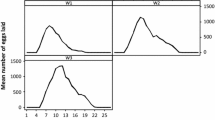Abstract
The engorgement weights of laboratory-raised nymphs of five common ticks in the USA, Amblyomma americanum, Amblyomma maculatum, Dermacentor andersoni, Dermacentor variabilis, and Rhipicephalus sanguineus, experimentally fed to repletion on an adult sheep (Ovis aries) were evaluated to determine the sex of molted adult ticks. Length of feeding period of nymphs, molting success and durations, and sex ratios between tick species were also compared. Individual replete nymphs were weighed and allowed to molt to adults in a humidity chamber. Length of feeding duration was different by species (F4,7785 = 1963.79; P < 0.0001); R. sanguineus nymphs became replete fastest, followed by A. americanum, D. variabilis, A. maculatum, and D. andersoni. Significant difference in molting success was not detected. The mean body weight of engorged nymphs of A. americanum (t = 32.3; df = 662), A. maculatum (t = − 9.70; df = 255), D. variabilis (t = 15.7; df = 751), and R. sanguineus (t = 5.17; df = 560; all P < 0.0001) molting into females was greater than that of nymphs molting into males, whereas heavier D. andersoni engorged nymphs became males (t = 8.71; df = 480; P < 0.0001). Amblyomma maculatum nymphs that molted to females fed to repletion faster (t = 3.33; df = 265; P ≤ 0.001) than nymphs that molted to males and a higher proportion (χ2 = 48.4; df = 1, P < 0.0001) of A. maculatum and D. andersoni (χ2 = 8.19; df = 1, P = 0.004) molted to females than males. Our study demonstrated biological and behavioral differences in and between engorging nymphs of five ixodid species. These findings may aid in studies evaluating the role of tick sex in transmission of tick-borne pathogens.





Similar content being viewed by others
References
Aguirre DH, Vinabal AE, Guglielmone AA (1999) The life cycle of Amblyomma neumanni Ribaga, 1902 (Acari: Ixodidae) in the laboratory. Exp Appl Acarol 23(2):159–164
Anthony DW, Roby TO (1966) The experimental transmission of bovine anaplasmosis by 3 species of North American ticks. Am J Vet Res 27(116):191-198
Arthur DR, Snow K (1966) The significance of size in the immature stages of the Ixodoidea. Parasitology 56(2):391–397
Belozerov VN, Fourie LJ, van der Lingen FJ (1993) Sexual dimorphism in nymphal size of the Karoo paralysis tick, Ixodes rubicundus. Exp Appl Acarol 17(8):627–629
Bowman DD (2014) Arthropods. In: Bowman DD (ed) Georgis’ parasitology for veterinarians, 10th edn. Elsevier, St. Louis, pp 11–80
Centurier von C, Klima R (1979) Ein Beitragzur Biologie von Amblyomma variegatum (Fabricius 1974) Z. angew. Entomology 87:131–142
Cooley RA (1938) The genera Dermacentor and Otocentor (Ixodidae) in the United States, with studies in variation. National Institute of Health Bulletin No. 171
Cooley RA (1946) Genera Boophilus, Rhipicephalus, and Haemaphysalis (Ixodidae) of the New World. United States Public Healthe Service. National Institute of Health Bulletin No. 187
Cooley RA, Kohls GM (1944) The Genus Amblyomma (Ixodidae) in the United States. J Parasitol 30(2):77–111
Dusbabek F (1996) Nymphal sexual dimorphism in the sheep tick Ixodes ricinus (Acari: Ixodidae). Folia Parasitol 43(1):75–79
Dusbabek F, Kopecky J, Uhlir J (1994) Effect of repeated infestations of BALB/c mice with Ixodes ricinus nymphs on tick-borne encephalitis virus infection. Folia Parasitol 41(4):312–316
Guglielmone AA, Moorhouse DE (1985) Differences in nymphs of Amblyomma triguttatum triguttatum Koch moulting to males of females. Acarologia 26:7–11
Hu R, Rowley WA (2000) Relationship between weights of the engorged nymphal stage and resultant sexes in Ixodes scapularis and Dermacentor variabilis (Acari: Ixodidae) ticks. J Med Entomol 37(1):198–200
James AM, Freier JE, Keirans JE, Durden LA, Mertins JW, Schlater JL (2006) Distribution, seasonality, and hosts of the Rocky Mountain wood tick in the United States. J Med Entomol 43(1):17–24
Kahl O, Hoff R, Knulle W (1990) Gross morphological changes in the salivary glands of Ixodes ricinus (Acari, Ixodidae) between bloodmeals in relation to active uptake of atmospheric water vapour. Exp Appl Acarol 9(3–4):239–258
Kocan KM, Stiller D (1992) Development of Anaplasma ovis (Rickettsiales: Anaplasmataceae) in male Dermacentor andersoni (Acari: Ixodidae) transferred from infected to susceptible sheep. J Med Entomol 29(1):98–107
Little SE, Hostetler J, Kocan KM (2007) Movement of Rhipicephalus sanguineus adults between co-housed dogs during active feeding. Vet Parasitol 150(1–2):139–145. https://doi.org/10.1016/j.vetpar.2007.08.029
Mixson TR, Campbell SR, Gill JS, Ginsberg HS, Reichard MV, Schulze TL, Dasch GA (2006) Prevalence of Ehrlichia, Borrelia, and Rickettsial agents in Amblyomma americanum (Acari: Ixodidae) collected from nine states. J Med Entomol 43(6):1261–1268
Oliver JH Jr (1977) Cytogenetics of mites and ticks. Annu Rev Entomol 22:407–429
Sauer JR, Hair JA (1986) Morphology, physiology, and behavioral biology of ticks. Halsted Press, New York
Sonenshine, DE, Hynes, WL, Ceraul, SM, Mitchell, R, Benzine, T (2005). Host blood proteins and peptides in the midgut of the tick Dermacentor variabilis contribute to bacterial control. Exp Appl Acarol 36(3):207–223. https://doi.org/10.1007/s10493-005-2564-0
Yeruham I, Hadani A, Galker F (2000) The life cycle of Rhipicephalus bursa Canestrini and Fanzago, 1877 (Acarina: ixodidae) under laboratory conditions. Vet Parasitol 89(1–2):109–116
Zivkovic Z, Nijhof AM, de la Fuente J, Kocan KM, Jongejan F (2007) Experimental transmission of Anaplasma marginale by male Dermacentor reticulatus. BMC Vet Res 3:32
Author information
Authors and Affiliations
Corresponding author
Additional information
Publisher’s Note
Springer Nature remains neutral with regard to jurisdictional claims in published maps and institutional affiliations.
Rights and permissions
About this article
Cite this article
Nagamori, Y., Payton, M., Coburn, L. et al. Nymphal engorgement weight predicts sex of adult Amblyomma americanum, Amblyomma maculatum, Dermacentor andersoni, Dermacentor variabilis, and Rhipicephalus sanguineus ticks. Exp Appl Acarol 77, 401–410 (2019). https://doi.org/10.1007/s10493-019-00346-8
Received:
Accepted:
Published:
Issue Date:
DOI: https://doi.org/10.1007/s10493-019-00346-8




